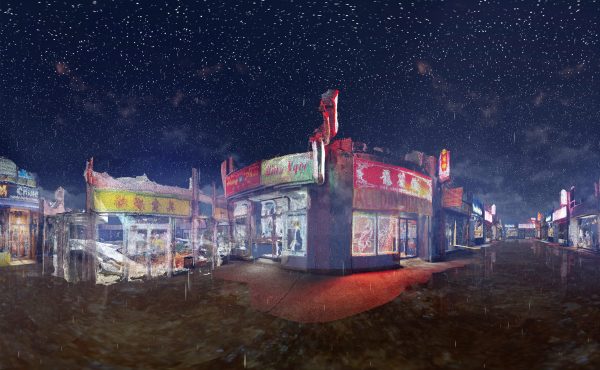Editor’s note: In the following weeks, a series of blog posts will investigate the emerging concept of the Naturally Occurring Cultural District (NOCD). Posts will explore the ways in which the NOCD concept could be applied to specific areas in Toronto to inform more equitable, localized forms of cultural planning.
![]()
Toronto’s “Cultural Renaissance” that followed the 2003 release of the Culture Plan for the Creative City framework saw massive redevelopment of several large-scale cultural institutions in the downtown core, including the Royal Ontario Museum, the Four Seasons Center for the Performing Arts, and the Art Gallery of Ontario. It was big, it was bold, and it represented the largest investment in Toronto’s cultural sector to date.
Cultural planning at this scale has swept the continent in the past decade in an effort to revitalize downtowns, attract business investment, and boost real estate prices. But what about the small-scale arts spaces and cultural organizations that provide much-needed opportunities for community engagement with the arts? What about the unique cultural sector industries that imbue the city with vibrancy and their neighbourhoods with a sense of the place? As an alternative to these large-scale, municipally directed cultural redevelopment projects, great community and economic development potential is to be found in the existing cultural resources and naturally occurring arts communities in our cities.
In the mid 80’s, the term ‘Naturally Occurring Retirement Community (NORC) was coined to describe the urban phenomenon of significant senior communities that were not purpose-built to accommodate for such populations. NORCs develop organically into concentrated communities of elderly persons living in their home neighbourhoods, facilitating generational diversity in the city. Since it’s creation, the NORC designation has been applied to communities across the United States. Recognition of the existing strengths and pressing needs of these Naturally Occurring Retirement Communities has influenced local, state, and federal policy to provide funding to support senior services in these areas, including social work services, health care programs, socialization and recreation activities, and community engagement efforts.

Inspired by the ground-up clustering of uses described by the NORC designation, a new term has been developed: NOCDs, or ‘Naturally Occurring Cultural Districts’. Susan Seifert, director of University of Pennsylvania’s Social Impact of the Arts Project, has defined Naturally Occurring Cultural Districts as organically-developed concentrations of cultural assets in particular urban areas. Such cultural assets that comprise NOCDs include artist residences, a range of art, theater, and music performance and work spaces, and creative industry firms. United by geography, these cultural clusters develop slowly over time to meet the needs of a local artistic or creative constituency.
NOCDs are community-initiated hubs of creativity and innovation, distinguished from municipally-planned cultural initiatives in that they are sustainable, self-determining, and deeply connected to their local context. This clustering cultural organizations and small art spaces has been shown to build strong cooperative social networks, to the benefit of existing cultural-sector businesses. Moreover, performance-based NOCDs may become cultural destinations for visitors from outside the community, supporting existing arts activities and generating positive spillover effects in the service and hospitality sectors. In addition to numerous economic benefits, NOCDs may also help to produce social and civic benefits to residents by reinforcing neighbourhood diversity and place-based cultural identity.
In New York City, a unique assemblage of artists, creative industry workers, and activists has formed the NOCD-NY Working Group based on shared support for the social and economic potential of NOCDs in the city. By raising the visibility of existing cultural districts, fostering collaboration between regional partners, and developing policy recommendations to support NOCDs throughout the city, the NOCD-NY Working Group seeks to strengthen the ability of such cultural districts to positively influence local community and economic development.
The NOCD concept is gaining traction; the efforts of the NOCD-NY Working Group have helped to advance the agendas of a number of existing cultural districts in the city, including El Puente, a Williamsburg, Brooklyn-based organization that promotes community environmental justice through arts and educational engagement, and Fourth Arts Block, a membership-based incubator for arts organizations in the East Village.
As evidenced, an understanding how NOCDs develop and recognition of existing cultural districts in our cities has the power to deeply influence cultural planning and policy-making at the municipal level. By supporting existing cultural resources, rather than imposing large-scale cultural infrastructure on communities, the NOCD model allows for a more inclusive and equitable conception of what constitutes local culture and what kinds of culture ought to be supported by policy-makers.
Photo by Gadjo Cardenas Sevilla





2 comments
What an interesting and EXCITING piece. Flawlessly written too.
I have a serious issue with the wide-spread religious discrimination practiced by governments of all stripes in their cultural support policies. If we really adopt a policy of “supporting existing cultural resources” this means the majority of the cash will go to religious institutions. I suspect that the existing pervasive religious discrimination means that is not going to happen.